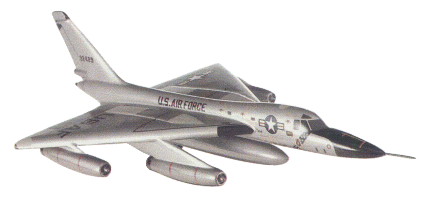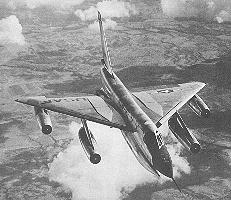 |
The supersonic B-58 Hustler derived from a new concept developed in the late 1940s and early 1950s. It took into account the greatly increased capability of ground defenses, including radar tracking and ground-to-air missiles. |
|---|
|
The Convair firm of Fort Worth, Texas--to be merged in 1954 with the General Dynamics Corporation--had been involved in advanced bomber design studies since October, 1946, when it had undertaken under contract with the Air Force a theoretical study of the long range subsonic bomber of the future, known as GEBO (GEneralized BOmber) I. Approximately 10,000 configurations on paper were studied and compared, with respect to speed, range, and gross weight, and involving different combinations of wing area, aspect ratio, sweep-back, turboprop and pure jet propulsion. Ultimately this study led to an Air Force requirement for a medium bomber with a gross weight of 200,000 lb., a radius of 2000 miles, and a 10,000-lb. bomb load. Boeing received a Phase I contract in 1948 under this requirement for their XB-65 with four jet engines and four turboprops, but the program was cancelled early in 1949 with the realization that this subsonic design would not have penetration capability against modern ground-to-air defenses. On June 6, 1949, Convair received from the Air Force a contract to continue generalized bomber studies under the designation of GEBO II. Initially, they were called on to attempt to settle the turboprop vs. turbojet power plant controversy, and to apply the solution to a bomber with a radius of 1200 to 2500 nautical miles with a 10,000 Ib. bomb load, cruising speed of over 450 knots, and flight altitude above 35,000 feet. In April, 1950, the GEBO II requirement was changed for a system able to attack targets 3000 to 4500 nautical miles distant at speeds of Mach 0.9 to 1.5. Convair had already proposed in January, 1950, a small delta wing composite carrying 2 men, which would be transported into the target zone by a B-36. With one engine in the tail, two droppable jet engines under the wings, and one in the tail of the long, finned bomb pod (all without afterburners) the parasite would have a launch weight of 100,000 pounds, would cruise to the target at Mach 1.3 (increasing to Mach 1.6 over the target), and reach a maximum altitude of 48,500 feet before pod release. After the attack the "return component" would fly back to the B-36 with its single engine at Mach 0.9. A modification in the fall of 1950 involved two fixed jet engines buried in the wings, two droppable engines under the wings, and a fifth in the long, streamlined pod, plus an advanced bombing/navigational system and passive electronic countermeasures system but no active defense. Originally the pod was intended to carry conventional explosives, but early in the GEBO II program a thermonuclear warhead was incorporated. The long, finned and streamlined bomb with a jet engine in its tail could function as a free-fall bomb; with small wings as a powered glide bomb or an air launched missile, and as late as 1953 it was expected that the pod, with propellant system and fins, would have a range of 100 nautical miles.
Though Boeing's large jet and turboprop XB-55 had been cancelled, the Seattle firm was working on a four jet shoulder wing bomber, their Project MX-1022, with 47-degree sweep-back of the leading edge, a tail reminiscent of that of the B-47, and a three-man crew. (Later this was to be referred to as the XB-59). Radius was 2,280 nautical miles at Mach 0.9, or 1,737 nautical miles at Mach 0.9 plus 185 nautical miles at Mach 1.3. The Air Force budget for fiscal 1951 and 1952 supported both the Boeing design and the Convair GEBO II delta parasite, and in February, 1951, both firms received Phase I contracts. The Convair MX-1626 proposal was for a small delta wing bomber to be carried as a parasite under a turboprop powered B-60, the swept-back variation of the B-36. It would now have only three non-after-burning engines, two fixed ones in wing nacelles and one in the pod, a gross weight of 107,000 Ib., a two-man crew, and a minimum landing gear to carry the weight of the "return component" only. During the Phase I studies of the MX-1626 proposal the parasite approach was dropped in favor of in-flight refueling using the early probe-and-drogue method just then coming into service. The expendable engine principle was also discarded, and the MX-1626 design which emerged in December, 1951 was for a small delta with two fixed engines in nacelles in the wings--for the first time with afterburners--and a long slender bomb pod, its nose extending forward beyond that of the aircraft and containing search radar gear, its tail garnished with three long swept-back fins, and its upper surface fayed flush to the lower portion of the fuselage. With a crew of three, this craft had a radius of 2300 nautical miles from advance bases, or 4000 nautical miles in intercontinental operations, with a single out-bound refueling at a distance no greater than 2500 nautical miles; the bomb pod, functioning as an air-to-ground missile, had a range of 50 nautical miles. |
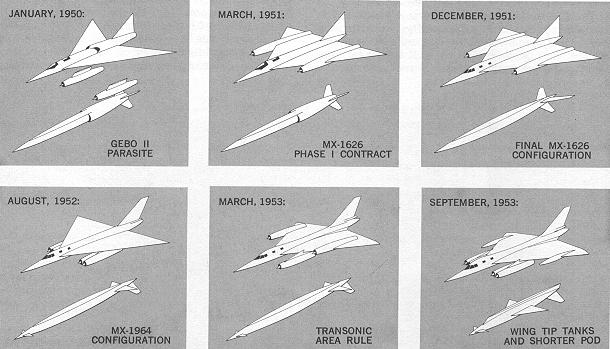
|
|---|
| The progress of the two supersonic designs encouraged Headquarters USAF Directorate of Requirements to publish on December 8, 1951, a General Operational Requirement (GOR) for a strategic bombardment system (SAB-51) with a minimal operational radius using the single refueling concept of 2000 nautical miles, a 2300 nautical mile radius at 50,000 feet, low altitude capability at high subsonic speed, and maximal supersonic dash capability. A strategic reconnaissance system (SAR-51) of February 1, 1952, sketched a similar aircraft for reconnaissance purposes. Both Boeing and Convair competed for a contract under the two GORs, the Convair contender, designated the MX1964, resembling the MX-1626, but having four jet engines with afterburners in paired pods in each wing, takeoff gross weight increased to 140,000 lb., the wing area increased to 1400 square feet, with leading-edge sweep-back of the delta wing decreased to 60 degrees. A tail turret with machine cannon was added. Boeing continued work on their design, now the MX-1965, reducing the weight from 200,000 to 180,000 lb., but when both detail Phase I designs were presented to Air Research and Development Command on October 9, 1952, the larger Boeing design was rejected as being less capable of achieving the specified supersonic performance. The Convair design was held to provide the most promising means of achieving supersonic capability with minimum size, thanks to the Convair engineering staff's insistence on producing a "high density" aircraft. In addition, Convair was 4 to 6 months ahead of Boeing in detail design. Convair thus received a full scale Phase I development contract under the Weapon System concept, using the MX-1964 design as a basis, with the further instruction that the aircraft would be known as the B-58. At this time the Convair design staff was using the name "Hustler" within the family to designate the MX1964; to the regret of some, the name stuck, and even became official. |
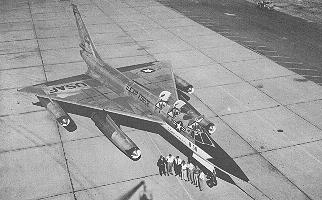 |
The Convair design staff was using the name "Hustler" within the family to designate the MX1964; to the regret of some, the name stuck, and even became official. |
|---|
|
The rest was refinement and detail. In March, 1953, the after fuselage was fined down under the
transonic "area rule" and the four engines were distributed in four separate, staggered pods. The
leading edge of the wing was cambered and twisted to minimize loss of efficiency at the tips. A
small 10-degree trailing edge angle was added to the wing, increasing the area to 1542 square
feet, and the takeoff weight increased to 150,000 Ib. In September, 1953, the four jet engines
were again in twin pods hung on pylons under the wings, with added fuel for intercontinental
flight in wing tip tanks. The search radar, which had extended out ahead in the nose of the bomb
pod, was mounted in the nose of the aircraft, enabling the pod to be shortened. In August, 1954,
the airframe was redesigned for the last time in the light of the supersonic "area rule." The jet
engine nacelles were hung individually under the wings, the fuselage redesigned, with added room
for fuel permitting the tip tanks to be eliminated. Wind tunnel tests confirmed that a significant
increase in supersonic performance could be expected. This design was unchanged up to the date
of the first flight on November 11, 1956, though for some time further the pod carried small
canard lifting surfaces forward, and triangular wings amidships.
Among the many revolutionary advances embodied in the B-58 Hustler was the use of new procedures and materials in constructing the aircraft. Special demands were made on the airframe structure, not only in terms of aerodynamic loads, but also by virtue of its high speed, which through skin friction at Mach 2 could heat the exterior surfaces above 250 degrees F. With the inboard jet engines venting their exhausts beneath the wing, there was also concern over sonic fatigue at high sound levels affecting the wing structure. In tie-down tests Convair actually ran the inboard engines of a B-58 for ten hours with afterburners in maximum re-heat and sound levels up to 171 decibels to test the wing structure for sonic fatigue. |
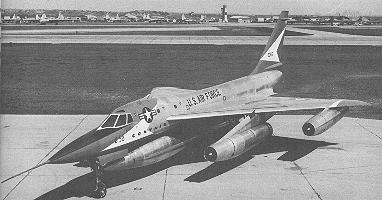 |
Among the many revolutionary advances embodied in the B-58 Hustler was the use of new procedures and materials in constructing the aircraft. |
|---|
|
Internally, the B-58 is framed like a Navy destroyer, with transverse duralumin spars, corrugated
for strength, spaced only 11 to 15 inches apart running from one wing margin through the
fuselage to the opposite wing. There are no chordwise ribs, only chordwise members or bulkheads
to serve as attachments for elevons, engine nacelles and landing gear. For covering the wing,
Convair evolved a new material--at once stiff, strong, light, relatively easy to replace, and with
good thermal-insulating qualities--the so-called bonded sandwich panel. The top and bottom of
the sandwich are sheets of duralumin alloy about 1 mm. thick; the half-inch-thick filling consists of
tiny honeycombs of either phenolic resin-fiberglass cloth, or less commonly, of very light gauge
duralumin. The core is bonded to the duralumin outer layers with phenolic adhesives and cured at
a pressure of 175 psi at 350 degrees F. for two hours. Absolute cleanliness is essential for solid
bonding, and the department of the Convair plant where this was done was known as the "hospital
section." The panel is then attached to the wing structure with titanium screws. Because it is
absolutely impossible to bend or deform a cured sandwich panel, those with curved surfaces have
to be set up in a jig before bonding. Fuselage structure panels are reinforced with beaded inner
skins bonded to the outer skins. In a few areas exposed to high temperatures, such as the after
portion of jet engine nacelles and the elevons which dip into the blast of the inboard jet units,
panels of brazed stainless steel sandwich replace the duralumin and fiberglass ones.
In line with the high-density concept under which Convair engineers designed the B-58, the entire interior of the wing, and most of the interior of the fuselage, are filled with fuel. Actually the space enclosed by the wing and fuselage aft of the crew compartment is divided by bulkheads into four tanks. The largest is the after tank, filling the after portion of the wing and containing a maximum of 39,794 Ib. of JP-4 fuel. The forward tank in the forward part of the wing contains a maximum of 20,648 Ib., and the reservoir tank above the wing, 4,163 Ib. In the tail of the aircraft at the level of the elevons is the balance tank, containing a maximum of 8,195 Ib. of fuel. The pod or pods carried beneath the aircraft are also largely filled with fuel. The single 57-foot-long MB pod contains mostly fuel. The 54-foot-long lower element of the two-part TC pod, designed to be dropped before run-in to the target, is filled entirely with fuel, while the 35-foot-long upper pod contains at least 2,450 Ib. of fuel as well as a warhead. When fully serviced by air refueling, the Hustler can carry in its internal and pod tanks a maximum of 101,627 Ib. of JP-4--over 57% of its gross weight of 176,890 Ib. in this condition. |
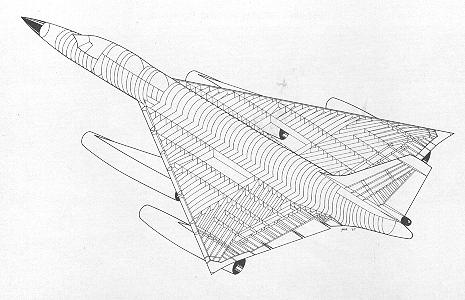 |
Internally, the B-58 is framed like a Navy destroyer, with transverse duralumin spars, corrugated for strength. |
|---|
|
The balance tank in the rear serves a particular purpose. At supersonic speeds, the center of
pressure moves well aft of its location at subsonic velocities, and the aircraft's center of gravity
should follow it, to reduce drag for the most economical cruise condition. The location of the
center of gravity is presented as a percentage of the mean aerodynamic chord (MAC) of the
aircraft, and for certain flight conditions the pilot is advised to set the center of gravity at the
corresponding correct MAC. (For example, with a gross weight over 100,000 Ib. and speeds
above Mach 1.3 the center of gravity below 50,000 feet must be kept within limits of 30%
forward and 33% aft of the MAC). An automatic computer-controlled programmer will arrange
for fuel to be pumped aft from the forward tank to the balance tank, or forward into the forward
tank, as necessary to bring the center of gravity within the required limits. The four engines of the
B-58 Hustler--General Electric J 79-5As or 5Bs--are rated at 10,000 lbs with maximum
afterburner. The engines are remarkable for having variable-position inlet guide vanes and
variable-position stator vanes in the first six stages of the compressor. These are automatically set
in relation to engine speed and compressor inlet temperature, to admit the correct amount of air
to the compressor, and to direct it against the rotating compressor vanes at the proper angle of
attack, thereby minimizing the possibility of compressor stall. Primary and secondary exhaust
nozzle flaps in the engine outlet area provide for optimum thrust and specific fuel consumption
under different engine operating conditions, and are opened or closed by the throttles. In addition,
they prevent engine overheating. The throttles have six settings, OFF, IDLE, and MILITARY. To
achieve "design speed" the Hustler has to be driven by the afterburners, and these increase their
thrust as the throttles are advanced to MIN A/B, MAX A/B, and OVSP. In the latter setting the
engines are allowed to overspeed to 103.5%; operations at 105 to 107% r.p.m. are permitted for
five seconds or less, but operation above 107% r.p.m. for any length of time requires that the
engines be returned to the factory for overhaul.
With a takeoff gross weight of 163,000 Ib., and a landing gross weight of 75,000 Ib. and a touchdown speed of 165 knots, the landing gear, wheels and brakes of the B-58 take terrific punishment. The steerable nose gear has two tires; the two main gears roll on four non-frangible steel wheels, each bearing two 22-in diameter tires inflated to 240 p.s.i. Should all the tires blow and disintegrate in a bad landing, the aircraft will roll on the non-frangible steel wheels. Enormous amounts of energy, up to ten million foot-pounds per brake, may be absorbed in a normal landing. Even higher energies may heat the brakes to such a degree that tires or hydraulic fluid may ignite, and firefighters must remember to approach the landing gear from front or rear only due to the danger of tire explosions. |
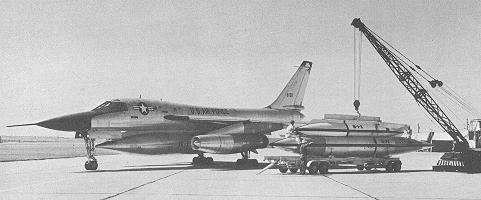 |
|---|
| The pod or pods carried beneath the aircraft are also largely filled with fuel. The single 57-foot-long MB pod contains mostly fuel. The 54-foot-long lower element of the two-part TC pod, designed to be dropped before run-in to the target, is filled entirely with fuel, while the 35-foot-long upper pod contains at least 2,450 Ib. of fuel as well as a warhead. |
|
Generators driven by # 1, 2 and 3 engines provide 115/200 volt alternating current, which powers
most of the instruments, some of the radar equipment, the fuel pumps and some of the
navigational equipment. Some of the alternating current is rectified to provide multiple direct
current between 28 and 250 volts including caution and warning lamps, autopilot, navigational
electronics equipment, and some of the radar apparatus. A 28 volt battery emergencies. The
Defense Systems Operator's cockpit is practically lined with panels of individual fuses which may
be checked by running the hand over them, a small pin protruding about an eighth of an inch from
a blown fuse. Other fuse panels are in the navigator's cockpit.
There are two separate and independent hydraulic systems, the utility and the primary, each having two engine-driven pumps maintaining a pressure of 3000 p.s.i. Both systems share in the operation of the flight controls, the elevons and rudders; should one fail the other system assumes the full load; should both hydraulic systems fail, the pilot has no means of controlling the aircraft and the crew must eject. The hydraulic systems also operate the landing gear, nose wheel steering, wheel brakes, tail turret, aileron, elevator and rudder damper servos. A pneumatic system is provided for emergency extension of the landing gear and for emergency braking. |
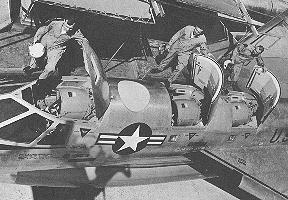 |
There is no physical communication between the three cockpits. |
|---|
|
There is no physical communication between the three cockpits arranged in tandem, and except
for the intercom each crew member is on his own, in cramped quarters which do not permit
standing, for missions lasting 7 to 8 hours. The pilot has vision ahead and to the sides through a
six-window wrap-around windshield, plus two small windows in the canopy for overhead vision.
The bombardier/navigator and defense systems operator have a minute window measuring not
more than 4 x 6 inches on each side of their compartments. These might seem to serve solely as
antidotes to claustrophobia, but often are covered by opaque cloth curtains the better to view
radar scopes within the cockpits. Each cockpit has its own individual, jettisonable canopy, hinged
at the rear and moved pneumatically.
Each cockpit also has an individual escape capsule--the first enclosed escape system in an aircraft in regular service use. Flight personnel are "sized" for the capsule at the start of the training course, and failure to fit the capsule is a cause for separation from the B-58 program. The capsule can be closed and pressurized within 7 seconds in case of loss of cabin pressure at high altitude, enabling flight personnel to dispense with pressure suits. In this situation the pilot can see part of his instrument panel through a window in the capsule door, and with full control through the stick inside the capsule, he may fly the aircraft to an altitude below 40,000 feet and decapsulate. Buttons on the stick enable him while encapsulated to disconnect the autopilot, shift the center of gravity, and retard the throttles. In an emergency, rockets eject the capsule from the aircraft, with the enclosed personnel being protected against wind blast, wind blast erosion and thermal injury. After deceleration of the capsule, a 41-foot diameter parachute lowers it. The capsule contains survival gear, including a radio, rations, water, desalting gear, clothing, and a rifle, and will float if it lands in the sea. |
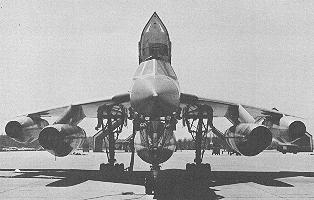 |
So much can go wrong, so fast in the B-58 Hustler. |
|---|
|
Liquid oxygen is carried, and crew members use the diluter-demand regulator, with pressure
breathing masks. The interior of the crew space is cooled by two separate air conditioning
systems. This is as much for the benefit of the large amount of electronic equipment carried as for
the crew, and in fact, if the amount of air from the cabin cooling system is insufficient to maintain
safe temperatures in the electronic gear, the cooling plant goes into "reverse flow" and the
electrical equipment is cooled before the cabin. A pressure regulator in the cabin exhaust vent
maintains a pressure differential of up to 7.45 p.s.i.
As for the electronic equipment itself--I still remember the laughter when I first told members of the 43rd Bomb Wing that I had heard that the Hustler was so complicated and tricky to fly that its operation was completely automated, with control movements automatically programmed by a reel of tape brought out from Operations and stuck in a black box in the nose! The Hustler is still a pilot's airplane, yet the extent and sophistication of the computerized and miniaturized control and navigational equipment is incredible, and enormously extends the perceptions and performance of the three human operators. To guide the Hustler, the pilot has a pair of conventional rudder pedals and a massive plastic control stick with which he makes the conventional control movements. Yet he is not moving the rudder and the elevons--the horizontal control surfaces at the rear of the delta wing--but merely activates valves which, through a power control linkage assembly, move the control surfaces by hydraulic force. (Characteristic of the hydraulic control system is the phenomenon known as "stick talk back," the pulsating kick of the control stick when the hydraulic pressure fluctuates at the stick's extreme limits of movement). There is of course no transmission of control surface loads back through the stick and pedals, so artificial feel systems provide a substitute. Other sophisticated features of the flight control system are automatic, responding not to the will of the pilot, but to impulses from the autopilot amplifier computer assembly, which derives information from the air data computer (Mach number, temperature and altitude), the gross weight computer, the tracking and flight controller unit (pitch and roll corrections), the primary navigational system (pitch, roll and heading signals), and the rate gyro and accelerometer package. These assemblies not only control the action of the autopilot (which can even vary engine power), but also the operation of other automatic features of the flight control system. For instance, damper servos move the control surfaces automatically to damp the rate of pitch, roll and yaw, undamped movement of the Hustler at supersonic speed, in particular, being dangerous as the aerodynamic loads may exceed the structural limits. An automatic elevator trim system will position the elevons to maintain constant 1G flight with the control stick in neutral. The angle assumed by the elevator will vary with air speed, gross weight and location of center of gravity, and is indicated on the instrument panel on the elevator position indicator. Another dial indicates the amount of elevator movement available. This depends in turn on the air speed, and is determined by the elevator ratio changer. The latter, in response to Mach signals, varies the stick-to-control surface mechanical ratio, in order to protect the aircraft against excessive G loads. Thus, large control movements are desirable and necessary at low air speeds; at high subsonic speeds, control surfaces movement should be limited because of the high air pressures involved; at supersonic speeds, with the control surfaces blanketed by shock waves, larger surface movements are required to produce the same effect. The aileron controls likewise have automatic trim and ratio changers. |
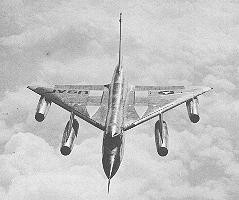 |
Wind tunnel tests confirmed that a significant increase in supersonic performance could be expected. |
|---|
|
So much can go wrong so fast in the Hustler that two separate warning systems --visual and
auditory--insistently draw the pilot's attention to any malfunction. On the left side of the
instrument panel is a red MASTER WARNING light, and a yellow one marked MASTER
CAUTION. When lit, these draw the pilot's attention to warning and caution panels on the right
side of the cockpit, where individual lamps indicate the specific trouble--"left (fuel) manifold low
pressure," "oil low #1," "reservoir tank not full," "aft pump #8," "hydraulic utility pump #2,"
"cabin pressure left," etc. An irresistible attention-getter, a voice warning system, has been
developed for the Hustler: into the masculine chatter in the pilot's earphones a
soft feminine voice (pre-recorded, unfortunately) breaks in with one of twenty
announcements--"weapon unlocked," "hydraulic system failure," "check for engine fire," "nose
too high." What dreams, I thought, the Hustler pilots must dream of this disembodied angel who
watches over their destinies ! I was speedily disillusioned. "I've seen her," shrugged one,
nonchalantly. "She's just like all the rest of them."
Of all the magically-performing electronic gear aboard the B-58, the Sperry-built AN/ASQ-42 bombing/navigation system gives the most astonishing performance. When operating in the navigation mode, it is literally capable of directing the B-58 Hustler, by acting through the autopilot, along a great circle track at constant Mach number and altitude to any point on the globe. The navigator simply sets the latitude and longitude of his true present position on his navigational control board, and the latitude and longitude of his destination position on the sighting and test panel. The computer filling the front of his cockpit does the rest, though not without the aid of a variety of sophisticated sensors which feed it data. |
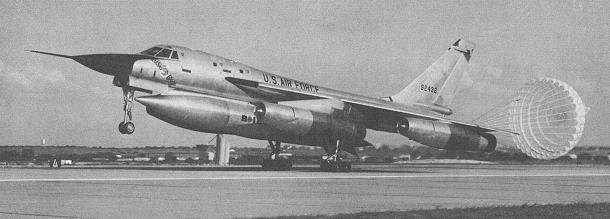 |
|---|
|
Towards the rear of the aircraft, in the fuselage between the forward and after fuel tanks, is the
inertial navigational system, the so-called stable table,3 whose attitude is gyroscopically fixed
while the aircraft moves around it in pitch, roll and yaw. It also provides a secondary measure of
ground speed. The primary ground speed source is a Doppler radar transmitter and receiver
enclosed within the tail of the aircraft, measuring the true ground speed by the decrease in
frequency between the transmitted radar pulse and the echo returned from earth. Atop the
stabilization unit, and protruding slightly above the skin of the fuselage, is the rounded cupola of
the star tracker unit. By setting on his astro control panel the Greenwich Hour Angle, the sidereal
hour angle, and the declination of the sun or star to be used for navigational purposes, the
navigator can cause the astro tracker to lock onto the heavenly body, after which it will provide
continuous heading information to the computer. Should the celestial bodies be obscured, heading
data comes in from the remote compass transmitter inside the leading edge of the fin. Search radar
in the nose, displaying a radar representation of the terrain below on the scope in the navigator's
cockpit, provides a further check on position. Crosshairs in the scope itself indicate when certain
fixpoints on the ground, pre-set into the computer, are coming into view. A radio altimeter
provides accurate height above the terrain. The air data system also feeds true air speed, pressure
altitude and air temperature into the computer.
In the bombing mode, the bomb/nav system takes the aircraft on a rhumb line course over the target, compensating for wind drift and Coriolis effect, while offset points and fixpoints set into the machine beforehand come up beneath the crosshairs in the radar scope. During the run-in the navigator, while watching the terrain below on radar, can make small corrections in heading with the tracking and flight control stick in his right hand, which acts through the autopilot. At a time calculated to provide a burst over the target, the bomb/nav system, in the bombing mode, automatically releases the weapon. For practice runs over radar bomb sites, the bombardier/navigator turns on a radio tone signal which is cut off abruptly at the moment of simulated weapon release. |
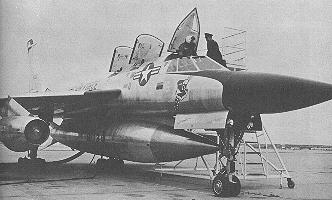 |
Each cockpit also has an individual escape capsule--the first enclosed escape system in an aircraft in regular service use. Flight personnel are "sized" for the capsule at the start of the training course, and failure to fit the capsule is a cause for separation from the B-58 program. |
|---|
|
The Defense Systems Operator, in the third cockpit, assists the pilot during flight by reading
check lists, advising the pilot on fuel consumption, optimum altitude, and location of center of
gravity. His primary duties are in connection with the passive and active defense systems. The
former comprises track-breaking electronic equipment designed to mislead and confuse the
operators of enemy radar, to enable the Hustler to accomplish its mission unaffected by
ground-to-air defenses. The latter includes a 6-barrel Vulcan 20 mm. cannon located in the
extreme tail, and the remote-control equipment needed to direct and fire it. Enemy aircraft are
presented as blips on the defense systems operator's radar scope, and the fire control equipment
automatically locks onto the target, computes the lead and windage, aims the gun and notifies the
DSO when to fire it--with the attacking enemy aircraft being at no time visible to the Hustler
crew.
After a bewildering afternoon watching flight crew trainees at work in the pilot's, bombardier/navigator's, and DSO's cockpit simulators, I confided to my friends of the 43rd Bomb Wing that it was surely easier to get through four years of medical school than to learn to fly the B-58 Hustler. "Too bad you can't take the six-month training course and find out," they replied. I wish I could try it |
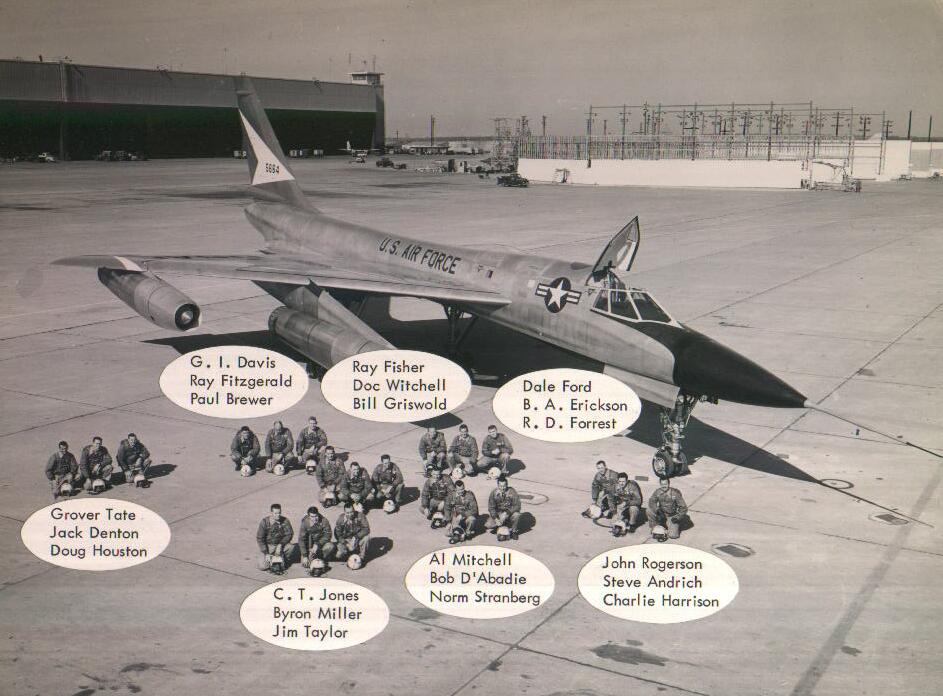
|
|---|
| Specifications: | |
|---|---|
| Convair B-58A Hustler | |
| Dimensions: | |
| Wing span: | 56 ft. 10 in (17.32 m) |
| Length: | 96 ft. 9 in (29.49 m) |
| Height: | 31 ft. 5 in (9.58 m) |
| Wing Area: | 1,542 sq ft (470 sq m) |
| Weights: | |
| Empty: | 55,560 lb (25,201 kg) |
| Max T/O: | 163,000 lb (73,935 kg) |
| Performance: | |
| Maximum Speed: | 1,321 mph (2,125 km/h) @ 63,150 ft (19,248 m) |
| Combat Ceiling: | 63,150 ft (19,248 m) |
| Record Ceiling: | 85,360 ft (26,017 m) |
| Combat Radius: |
1,750 miles (2,816 km) to, 5,577 miles (8,975 km) with inflight refueling |
| Powerplant: | |
|
Four General Electric J79-GE-1 turbojet engines rated at 10,500 st. or 16,000 st. 69.4 Kn with afterburners. | |
| Armament: | |
|
Single General Electric T-171E3 Vulcan 20 mm rotary cannon in the rear, plus nuclear or conventional bombs in the underwing pod. | |
Notes:
This page adapted from:
1. Robinson, Douglas H. The B-58 Hustler New York: Arco Publishing Company, Inc., 1967.
Return to Aircraft Index
© The Aviation History Online Museum.
All rights reserved.
Created September 9, 1996. Updated December 13, 2015.


